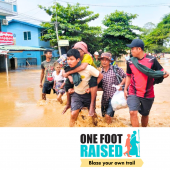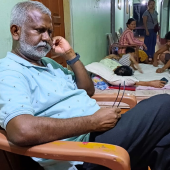Poor people inspire Myanmar girl to become social worker

A young girl, who lives in Amatgyi village in Pyinsalu Township located in Latbuta district in Ayeyarwady Region of Myanmar, got inspiration from the sick and the poor to become a social worker.
“When my mother was hospitalized, I attended her. And I saw many poor patients who were in trouble with finance and lack of food in the hospital,” says Ma Annie.
From that day onward, she was compassionate to the poor people and wanted to do charitable works in sympathy for them.
“Since I was a fifty-year-old girl, I individually started working on charitable activities by taking care of the sick elderly in my village in 1994,” Annie recalled.
A tsunami and earthquake occurred and the form of sand waves came up near their Island in 2005. Nothing happened to her village. But it severely caused many people to die in the village of Htan Pin Gone in the township of Pyinsalu.
However, casualties were mostly found in Kaing Thaung village which is located on the Island in Latbuta township.
“The news about it was not publicly known at that time. The population of death was not too much. Therefore, regardless of race and religion my close friends and I could bring bodies one after another to the hospital for medical tests and proof. Then, we buried lifeless bodies,” Annie says.
Many houses in the village of Kaing Thaung were damaged. The victims had nothing to cook and eat.
Annie collected money with her friends and bought blankets, mosquito nets, kitchen utensils, and clothes, and distributed them to over 80 households.
“I felt very sorry when I saw that they were in trouble and hopeless situations,” Annie says.
But when the victims saw Annei and her team coming to them with food aids, they were very happy with the tear of joy in their eyes.
At that time no charitable organization like Caritas Myanmar (the social service wing of the country’s Catholic bishops) was formed in the Region.
“Therefore, we, young people who worked in charity, collected money from one another and donated food aids and medicines to the tsunami victims without any discrimination against religion and race in our areas,” Annie recalled.
Despite being a Catholic, Annie crossed the border of diverse religions and worked for all walks of life in charity.
She said, “Most people I helped were Buddhist majority. They all appreciated my charitable work. They did not misunderstand me. They welcomed me whenever I went to them to present materials for their needs.”
There was an unforgettable person whom she closely gave health care. He was a sick Buddhist monk who lived alone at his monastery. He was at the age of 80 and lived in another village called Kwin Pauke close to her residence.
He suffered a severe asthma attack. He could not breathe. When she saw him staying alone at his monastery, she brought him to her house and carefully gave health care to him for 15 days.
After that, he could restore his health and survival. He is still alive until now. He currently lives in Thinbawgwin village not far from Annie’s village.
“He cannot forget my help and always says words of thanks to me whenever he meets me,” Annie says.
Another calamity which was Nargis Cyclone broke out in the Region of Ayeyarwaddy in southwest Myanmar on May 2, 2008.
A lot of people in the villages on the Island in the township of Pyinsalu in Latputta district encountered unprecedented disaster.
Annie’s area was strongly hit. Her village was overwhelmed by big waves which wiped out a lot of people. At that time, she survived. She saw many people living in her village were dead. Some became the victims of natural disasters.
As a girl of charity, she could not bear the sufferings of the victims. That is why she tried to find ways and means to help the survivors who were getting hungry and thirsty.
There was no more food and drinking water except salt water after the cyclone went down from the village.
Everything was lost. Even the roads of the villages were covered by falling trees including coconut trees. The cyclone stopped at 3 o'clock the next morning on May 3.
Luckily, Annie saw a petrol storage tank floating in the water and moving to her place. When she got it, she opened it and saw rice not gasoline inside the tank.
“I was very happy when I got it. Then, I distributed rice to each family of survivors in my village,” Annie says.
She wanted to go to other villages to help other villagers but could do so because there was no transportation at all. No humanitarian assistance came to them for two weeks.
Later the military government came to the victims by helicopter and brought some military medical doctors and nurses to the victims three weeks after the cyclone.
“I was joyful when we saw health workers,” Annie remembers.
But the next day, a helicopter came again. In her expectation, other health workers and medicines were brought to them. Sad to say, the medical doctors and nurses were retrieved by their officials although they willingly wanted to continue to work for the victims. Annie shed her tears.
Annie had done many charitable works such as feeding food to the poor children living in the cemetery of Hinthada town, donating robes to Buddhist monks, visiting the sick elderly in the hospitals, and offering cash to them.
Annie is single and currently suffering back pain because of spinal disease. But she is proud of the charitable activities she had already done before.
For the time being, she is under medical treatment and staying in Pathein town.
She is the youngest child out of eight children. Her parents had already passed away.
“I will continue to do this charitable work when I recover from back pain,” Annie says firmly.
“Whatever you did for one of the least of these brothers and sisters of mine, you did for me,” (Matthew 25: 40). It is the gospel message that she always reflects on it when she did charitable work.
(With inputs from Mahn Jim)
Radio Veritas Asia (RVA), a media platform of the Catholic Church, aims to share Christ. RVA started in 1969 as a continental Catholic radio station to serve Asian countries in their respective local language, thus earning the tag “the Voice of Asian Christianity.” Responding to the emerging context, RVA embraced media platforms to connect with the global Asian audience via its 21 language websites and various social media platforms.
















- Reply
Permalink